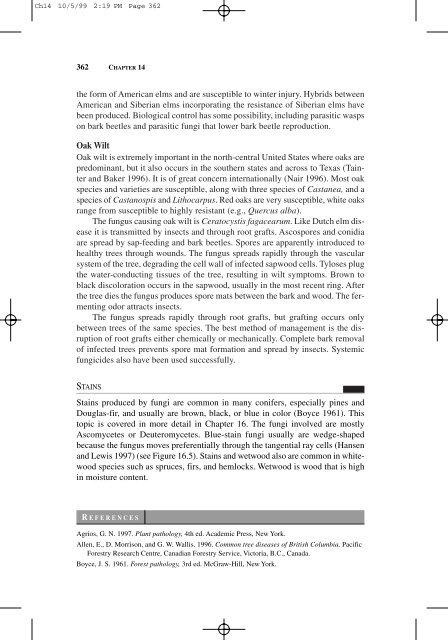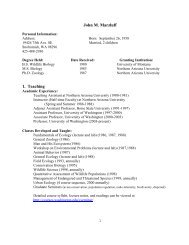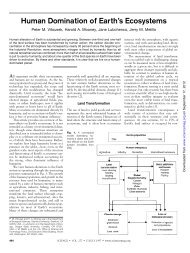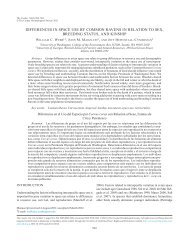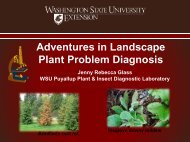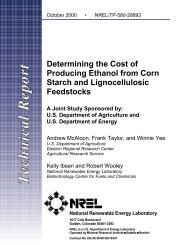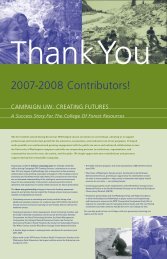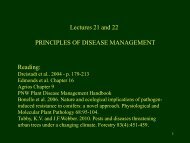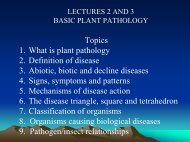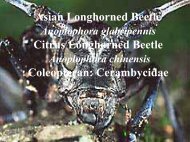Create successful ePaper yourself
Turn your PDF publications into a flip-book with our unique Google optimized e-Paper software.
Ch14 10/5/99 2:19 PM Page 362<br />
362 CHAPTER 14<br />
the form of American elms and are susceptible to winter injury. Hybrids between<br />
American and Siberian elms incorporating the resistance of Siberian elms have<br />
been produced. Biological control has some possibility, including parasitic wasps<br />
on bark beetles and parasitic fungi that lower bark beetle reproduction.<br />
Oak Wilt<br />
Oak wilt is extremely important in the north-central United States where oaks are<br />
predominant, but it also occurs in the southern states and across to Texas (Tainter<br />
and Baker 1996). It is of great concern internationally (Nair 1996). Most oak<br />
species and varieties are susceptible, along with three species of Castanea, and a<br />
species of Castanospis and Lithocarpus. Red oaks are very susceptible, white oaks<br />
range from susceptible to highly resistant (e.g., Quercus alba).<br />
The fungus causing oak wilt is Ceratocystis fagacearum. Like Dutch elm disease<br />
it is transmitted by insects and through root grafts. Ascospores and conidia<br />
are spread by sap-feeding and bark beetles. Spores are apparently introduced to<br />
healthy trees through wounds. The fungus spreads rapidly through the vascular<br />
system of the tree, degrading the cell wall of infected sapwood cells. Tyloses plug<br />
the water-conducting tissues of the tree, resulting in wilt symptoms. Brown to<br />
black discoloration occurs in the sapwood, usually in the most recent ring. After<br />
the tree dies the fungus produces spore mats between the bark and wood. The fermenting<br />
odor attracts insects.<br />
The fungus spreads rapidly through root grafts, but grafting occurs only<br />
between trees of the same species. The best method of management is the disruption<br />
of root grafts either chemically or mechanically. Complete bark removal<br />
of infected trees prevents spore mat formation and spread by insects. Systemic<br />
fungicides also have been used successfully.<br />
STAINS<br />
Stains produced by fungi are common in many conifers, especially pines and<br />
Douglas-fir, and usually are brown, black, or blue in color (Boyce 1961). This<br />
topic is covered in more detail in Chapter 16. The fungi involved are mostly<br />
Ascomycetes or Deuteromycetes. Blue-stain fungi usually are wedge-shaped<br />
because the fungus moves preferentially through the tangential ray cells (Hansen<br />
and Lewis 1997) (see Figure 16.5). Stains and wetwood also are common in whitewood<br />
species such as spruces, firs, and hemlocks. Wetwood is wood that is high<br />
in moisture content.<br />
R EFERENCES<br />
Agrios, G. N. 1997. Plant pathology, 4th ed. Academic Press, New York.<br />
Allen, E., D. Morrison, and G. W. Wallis. 1996. Common tree diseases of British Columbia. Pacific<br />
Forestry Research Centre, Canadian Forestry Service, Victoria, B.C., Canada.<br />
Boyce, J. S. 1961. Forest pathology, 3rd ed. McGraw-Hill, New York.


